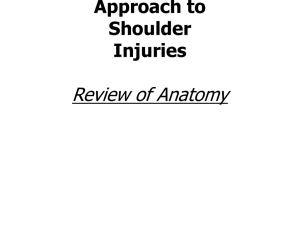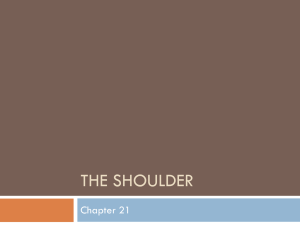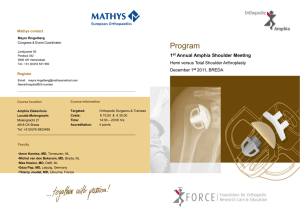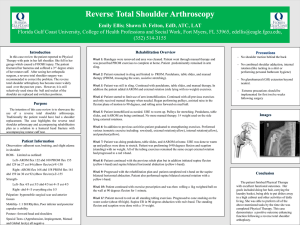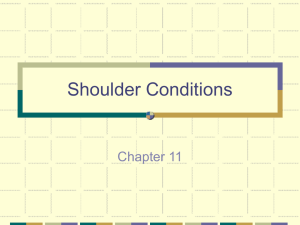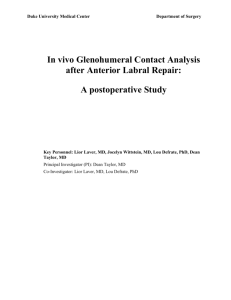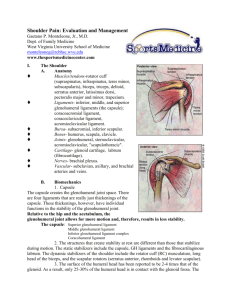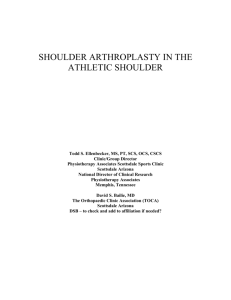Chapter 17 - Shoulder Student version
advertisement
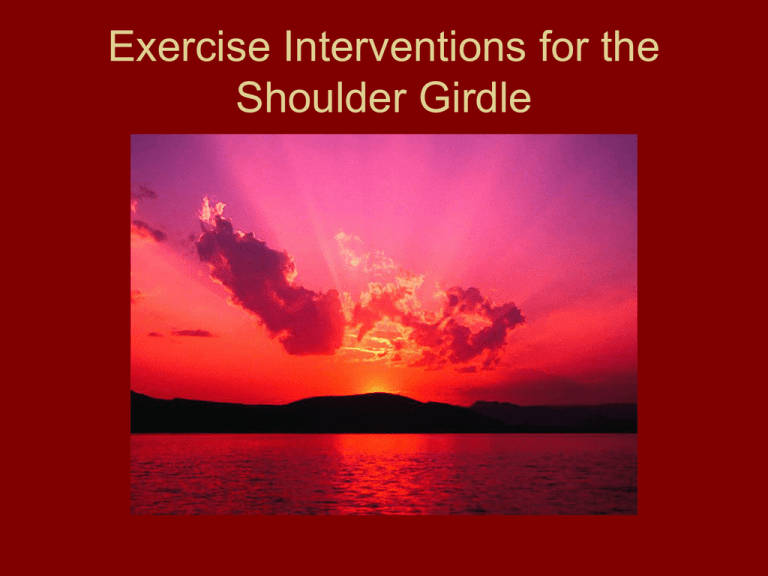
Exercise Interventions for the Shoulder Girdle Anatomy of the Shoulder Girdle Complex Joint Positions and Capsular Patterns Loose-Packed Closed-Packed Position/ resting Position position Capsular Pattern Glenohumeral Joint 55 deg. abduction, 30 deg. horizontal adduction Abduction and lateral rotation (ER) Lateral Rotation, abduction, medial rotation AcromioClavicular Joint Arm resting at side in normal physiological position Arm abducted to 90 degrees Pain at extreme range of movement Scapular and Glenohumeral Joint Motions • Scapular motions: elevation, depression, protraction, retraction (combined motions: upward / downward rotation, tipping) • GH motions: flexion, extension, abduction, adduction, IR,ER, horizontal abduction and horizontal adduction Figure 17.5 Kisner & Colby page 485 ‘Pattern for idiopathic frozen shoulder’ 1) Freezing= intense pain, even at rest, limited motion (may last 10-36 weeks) 2) Frozen= pain with movement, adhesions and substitute motion of the scapula , atrophy of muscle (may last 4-12 months) 3) Thawing= no pain / inflammation, but significant capsular restrictions from adhesions (may last 2-24 months or longer) -Idiopathic (unknown cause) frozen shoulder = adhesive capsulitis -dense adhesions, capsular thickening / restrictions especially in the deep folds of the capsule -slow onset, usually in the 40-60 year old population -may see spontaneous recovery at around 2 years after onset Glenohumeral Joint Hypomobility Managment • PROTECTION PHASE (ACUTE) *Control pain, edema, muscle guarding -may use immobilization, such as a sling (temporary) -intermittent PROM / AAROM within pain-free ranges *Maintain soft tissue, joint integrity, and mobility -PROM all planes, progress to AAROM -Pendulum Exercises (Codman’s)- uses gravity to distract the humeral head from the fossa (no use of weight at this phase) -gentle muscle setting *Maintain Integrity and Function of Associated Areas -keep unaffected joints mobile (neck, elbow, wrist/hand, etc) See HEP handouts for examples of shoulder muscle setting / isometrics as well as Codman’s exercises Pendulum (Codman’s) Exercises • • • • • • • It is important that the patient uses the momentum from their body weight rocking back and forth. No active shoulder motion! For gentle distraction (acute phase) do not use weight Using a light weight causes grade III (stretching) distraction force Motion can be side to side, clockwise, or counterclockwise See HEP handouts for other diagrams Figure 17.22 Kisner and Colby page 530 Multiple-Angle Muscle Setting • • Multi-angle muscle setting without resistance then progress to lowintensity resisted isometrics In later phases the patient can complete with greater resistance once further healing has occurred * Also see HEP handouts Figures 17.39 and 17.40 Kisner & Colby pg. 539 Glenohumeral Joint Hypomobility Managment • CONTROLLED MOTION PHASE (SUBACUTE) *Control pain, edema -PROM, progressing to AAROM (i.e. ‘wand’, ‘table top’ exercises) -may continue Codman’s *Progressively increase joint and soft tissue mobility -patient can be taught self-mobilization (caudal glide, anterior glide, and/or posterior glide) -manual stretching by PT/PTA -self-stretching exercises *Inhibit muscle spasm and correct faulty mechanics -avoid “hiking the shoulder” -strengthen RTC to prevent impingement *Improve muscle performance (correct faulty spine posture if needed) Wand Exercises • • • • • The involved extremity in this picture is the left UE (upper extremity) Placing a towel roll under the distal humerus decreases stress on the anterior joint capsule by decreasing extension at the GH (glenohumeral) joint The motion involved in both pictures is external (lateral) rotation See HEP handouts for further wand exercises Figure 17.21 Kisner and Colby pg. 530 Precautions • When progressing a therapy program, avoid exacerbation of symptoms – if symptoms do increase, decrease the intensity of the activity or withhold the activity altogether for now (may be able to re-address at a later time). Consult PT! Glenohumeral Joint Hypomobility Management • RETURN TO FUNCTION PHASE (CHRONIC STAGE) *Progressively Increase Flexibility and Strength -progressive stretching and strengthening as the tissue tolerates -emphasis is on correct mechanics, safe progression, and home exercise strategies -if capsular tissue is still restricting motion at this point consult with the PT (POC may need modification, i.e. PT may need to do joint mobilizations if they haven’t been already) -prepare for work or recreational activities (i.e. work hardening) -occasionally a patient may need to undergo manipulation under anesthesia to regain motion Self-Stretching Techniques Upper Extremity Plyometrics • Pictures depict a progression through a plyometric scenario • Begin with patient supported in a stable position, then progress to standing in one plane, followed by diagonal patterns through short and then full ranges of motion • Weight of the ball should start off light and can later become heavier as strength progresses • Figure 17.57 Kisner & Colby page 550 Glenohumeral Arthroplasty • Total Shoulder Replacement Arthroplasty (TSR)= both glenoid and humeral surfaces are replaced • Hemireplacement Arthroplasty (hemiarthroplasty)= one surface is replaced - Different ‘designs’ are used for these surgeries, may include: unconstrained, semi-constrained, and reverse ball and socket *each design has it’s own limitations and precautions (***close communication with PT is crucial to be compliant with the surgeon’s recommendations and to get the best outcomes) - Surgeon may give therapy a set of guidelines to follow, but the PTA should never progress a patient without consulting PT first. Glenohumeral Arthroplasty • If the rotator cuff was torn and also needed to be repaired, rehab will be slower and more caution must be used • Intraoperative ROM: surgeon “tests” the ROM of the shoulder before suturing back up, therapy goals are based on these findings (communication is very important!) http://www.akhanddoc.com/total_shoulder_replacement Glenohumeral Arthroplasty Postoperative Managment • Correct faulty posture to prevent impingement (may see forward head / shoulder posturing) • MAXIMUM PROTECTIONS PHASE (MAY be 1-6 weeks) – Patient education regarding precautions and HEP – Control Pain – Maintain mobility of adjacent joints – Gradually restore shoulder mobility (follow MD guidelines for when PROM, AAROM, etc are allowed and to what degrees) – Minimize muscle guarding and atrophy Glenohumeral Arthroplasty Postoperative Management • MODERATE PROTECTION / CONTROLLED MOTION PHASE (MAY begin around 4-6 weeks post-op and last 12-16 weeks +/-) *emphasis is on gaining active control, dynamic stability, and strength while continuing to increase ROM - - PT/ MD determines when patient is ready for this phase PT may order use of heat before tx to increase tissue stretch with ROM and may end with cryotherapy to decrease any inflammation and/or pain (no heat when patient is acute post-op) Gradual progression through PROM, AAROM, AROM as well as muscle setting and isometrics, progressing to light resistance when allowed (keep resistance exercises below 90 deg shoulder elevation) Precautions • When progressing a therapy program, avoid exacerbation of symptoms – if symptoms do increase, decrease the intensity of the activity or withhold the activity altogether for now (may be able to re-address at a later time). Consult PT! Glenohumeral Arthroplasty Postoperative Management • RETURN TO FUNCTIONAL ACTIVITY PHASE (MAY begin around 12-16 weeks and can last several months) *Pain-free strengthening for dynamic stability and functional use of the UE - PT/ MD determines when patient is ready for this phase, generally: full PROM (based on intraoperative ranges), AROM in the scapular plane to at least 100-120 deg. without substitutions, RTC 4/5 MMT - Patient may have to modify or eliminate certain functional and recreational activities indefinitely - gradual progression through end-range self stretching, PRE’s, weight bearing through the UE, dynamic stability, etc. Stop and Think! *Your patient is 4 days post-op left TSA 1) What does TSA stand for? 2) You should use a moist hot pack on her shoulder before tx, T/ F? 3) What ‘phase’ of rehab is she in? 4) What precautions do you need to educate her about? *She is now 6 weeks post-op and the physician’s written ‘guidelines’ suggest patient begin the moderate protection phase. The patient has been achieving all her goals so far….what do you do? • • What is the general progression for ROM activities? What is the general progression for strengthening activities? Shoulder Impingement Primary Impingement: Wearing of the RTC against the acromion during shoulder elevation *Supraspinatus Tendonitis Secondary Impingement: Results when there are faulty mechanics due to hypermobility or instability of the GH head http://www.bostonpaincare.com/shoulder_impingement_s yndrome Faulty Posture • Forward head, increased thoracic kyphosis, forward tilt of the scapula, IR of the humerus • Causes Muscle Imbalances -tight pectoralis minor, levator scapulae, scalenes, IRs -weak serratus anterior or trapezius muscles, ERs *Impingement occurs during UE elevation Figure 17.6 Kisner & Colby page 485 Painful Arc • Commonly seen with impingement syndromes • Can be due to compression of the RTC tendons and/or subacromial bursa within the subacromial space during elevation of the humerus http://www.watkinson.co.nz/painful_arc.htm Subacromial Decompression Surgery - Most decompression surgeries are now done arthroscopically May include: *Bursectomy (subacromial) *Release of the coricoacromial ligament *Acromioplasty (resection) *Removal of any osteophytes Rehab may be quicker if the RTC is intact and procedure is arthroscopic http://www.leadingmd.com/shoulder2_seaport/treat.asp Rotator Cuff Arthroscopic Repair Keep in Mind: -PROM (and later A/AAROM) only through “safe” (MD ordered) ranges and pain-free -Later in rehab, do not allow active shoulder elevation if the patient is hiking their shoulder -It is crucial to follow PT / MD restriction guidelines for ROM and allowed activities to prevent damaging the surgical repair http://rehabstudents.com/2010/05/shoulder-post-surgic Rotator Cuff ‘open’ Repair - Keep in Mind: -Overall rehab and progression through the stages / phases will be longer vs arthroscopic repair -Greater caution during rehab is indicated for these patients -Follow ROM / activities carefully and do not progress unless PT / MD approves http://www.adnetinc.net/images.htm Shoulder-Bankart Lesion Repair • Anterior shoulder dislocation usually results from a blow to the humerus when in abduction and ER causing damage to the anterior GH joint capsule and likely tearing the RTC • May also have a Hill-Sachs lesion (compression fx of the posterolateral edge of the humerus • Avoid strain to the anterior shoulder during early rehab (very limited ER & Extension) • http://www.sportsarthroscopyindia.com/ds.aspx Shoulder SLAP Lesion / Repair SLAP • Involves tearing of the Superior Labrum, Extending Anterior to Posterior • Can have a tear of the long head of the Biceps • During repair the surgeon may also need to perform anterior stabilization if there is instability http://www.shoulderdoc.co.uk/patient_info/shoulder-slap Special Tests for Shoulder Instability “Special Tests” for Shoulder Instability * Anterior apprehension Test for anterior instability http://accessmedicine.net/search/searchAMResultImg.aspx *Inferior apprehension Test for inferior instability http://www.aceproindia.com/ACE%20Sample%20Projects * Impingement Test http://quizlet.com/3033389/shoulder-tests-flash-cards/ * + Sulcus Sign for inferior instability http://www.shoulderdoc.co.uk/article.asp?article=798 Case Study • 1) 2) 3) 4) Your patient is a 15 year old baseball pitcher who has been having right shoulder pain for the past 2 months when pitching. During the initial evaluation the physical therapist observed a forward head/shoulder (slump) posturing and noted weak serratus anterior and supraspinatus musculature (4-/5). There is also tenderness upon palpation of the supraspinatus tendon at it’s insertion. The therapist has ordered modalities to decrease pain and inflammation, strengthening of the involved muscles, and patient education. Which modalities might the therapist have included in the plan of care? Give 3 exercises to strengthen the weak muscles and describe how you would progress them What information would you include in your patient education? Which muscle or muscles might be tight? How would you stretch them?



